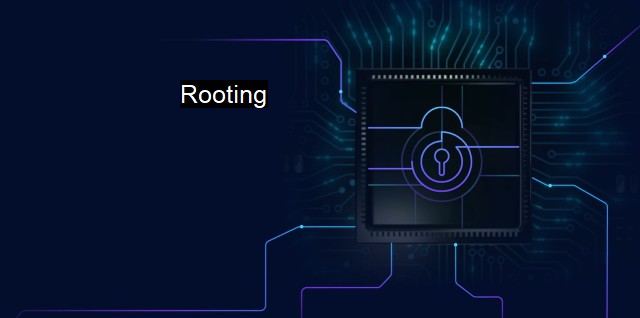What is Rooting?
The Pros and Cons of Rooting: Understanding Android Device Superuser Access and its Impact on Cybersecurity
Rooting, in the sphere of computer science, cybersecurity, and antivirus, is a unique term that holds significant importance. It refers to the process which bestows administrators, or 'superusers', with high-level permissions to the central operating system kernel. Initially coined for the Unix and Linux operating systems, it has now become a commonly used term across distinct operating systems like Android, since their clients hold a Unix-based core.Rooting is akin to jailbreaking in Apple's iOS environment, appliquéing system-level adjustments and migrations to open up locked functionalities and operative applications typically unavailable to the everyday user. Users endeavor to root their devices to eliminate blanket restrictions, placed by service providers, or to expand the capabilities of security and antivirus protections. this action also poses significant risks and challenges, continuously being a significant focus of conversations surrounding technology, cybersecurity, and antivirus.
While rooting offers several advantages – it unlocks premium features, facilitates full application control, enables customization and offers performance enhancements – its impact on cybersecurity is profound. Root access potentially destabilizes the inherent security features of a device since it subjects system interior to modifications. Therefore, it exposes the system to threats from malware and viruses, demanding intense observation.
Contrarily, rooting allows heightened cybersecurity measures and antivirus defenses that the conventional user does not have access to. Users with rooted systems can manage advanced firewall services, robust ad-blocking solutions, and intricate virus scanning applications enhancing overall device safety. Tracking permissions of different applications on the device's system is also an improved possibility for rooted users, expanding the security preference array and boosting potential protective methods.
Despite the escalated authorization, rooting does place the user in direct face-off with potential cybersecurity conflicts like voiding the software warranty or unconsciously enabling malicious malware. This risk arises due to the nature of rooting, diving deeper into the device system. For malware, it's an opportunity to infiltrate into system components and core processes, which can make antivirus protection futile. Security patches and regular updates, often not available to rooted systems immediately, can also lead to lax security and open channels for potential system corruption.
Viruses that affect rooted systems can leverage root permissions to inflict intense damage, affecting firmware and even resisting antivirus applications rendering them unable to diagnose or quarantine them efficiently. This affliction may extend to cloning confidential data, sensitive credential theft, and complete device control, posing unparalleled cybersecurity threats that call for reconsideration about the practical compensation rooting offers against inherent threats.
In the antivirus domain, rooting a device can amplify its threat defense mechanism. Escalated system authorization allows intricate virus and threat scans, both within existing applications and potential downloads. It is also possible for users to create system back-ups that are not traditionally possible, going as far as complete NANDroid backups – a bit by bit device restoration. The antivirus protections, therefore, can launch more robust defense algorithms, regular system health checks, and ailment diagnosis offering sufficient protection that makes rooting a favored avenue.
In sum, rooting, despite its cybersecurity and antivirus benefits, is not for the uninitiated. Outweighing the potential system enhancement dividends of permission escalation against potential cybersecurity threats is crucial. Venturing into rooting requires intricate technological skill, understanding, and adequate protective measures. Thus, understanding the cybersecurity risks against the power autonomy rooting unlocks is important. Critical, too, is comprehension about how it changes the antivirus functionalities and scope. Therefore, active forensic diligence and technological mindfulness are crucial to achieve a rooting experience that outvalues potential susceptibilities.

Rooting FAQs
What is rooting and how does it relate to cybersecurity?
Rooting refers to the process of removing restrictions on a device's operating system, giving users elevated permissions to access and modify system files. In the context of cybersecurity, rooting can bypass security protocols and leave the device vulnerable to malware attacks or compromise.Is rooting a safe practice for improving antivirus protection?
Rooting can potentially improve antivirus protection by allowing access to advanced features and settings. However, it also increases the risk of malware infections if proper precautions are not taken. It is recommended to consult with a professional before rooting a device for antivirus purposes.Does rooting a device void its warranty?
Yes, rooting a device may void its warranty as it involves modifying the original software and can cause damage to the device. It is important to consider the potential consequences before rooting a device, such as losing the ability to get support or repairs from the manufacturer.Can rooting an old device improve its security?
Rooting an old device can potentially improve its security by allowing access to security apps or features that are not available in the original software. However, it also carries the risk of leaving the device more vulnerable to malware attacks or compromise. It is recommended to weigh the potential benefits and risks before rooting an old device for security purposes.Related Topics
jailbreaking rootkit detection system vulnerabilities malware detection exploit mitigation
| | A | | | B | | | C | | | D | | | E | | | F | | | G | | | H | | | I | | | J | | | K | | | L | | | M | |
| | N | | | O | | | P | | | Q | | | R | | | S | | | T | | | U | | | V | | | W | | | X | | | Y | | | Z | |
| | 1 | | | 2 | | | 3 | | | 4 | | | 7 | | | 8 | | |||||||